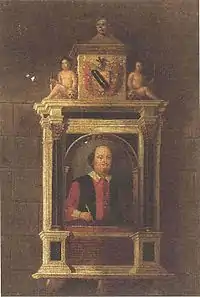Gerard Johnson (sculptor)
Gerard Johnson (Dutch: Gheerart Janssen; fl. 1612–1623) was a sculptor working in Jacobean England who is thought to have created Shakespeare's funerary monument. In May 1612 he was paid for making part of a fountain for the east garden at Hatfield House, Hertfordshire.[1]

His father, Gerard Johnson the elder, came to England in 1567 from Holland. He established himself as a sculptor of funerary monuments in London. Johnson's father had worked on a monument to the 1st Earl of Southampton, which also depicts Shakespeare's patron, the 3rd Earl, as a young man. Shakespeare would probably have seen the monument if he had stayed at Titchfield.[2]
The younger Johnson's monument is in Holy Trinity Church, Stratford upon Avon, and was probably commissioned by Shakespeare's son-in-law John Hall. The attribution to Johnson is contained in Sir William Dugdale's Antiquities of Warwickshire, published in 1656, but no other evidence of Johnson's authorship exists. Dugdale also states that the younger Johnson created the memorial in Holy Trinity church to Shakespeare's friend John Combe, who left the playwright a legacy in his will. This would probably have been installed in 1615 while Shakespeare was still alive. It is also possible that Shakespeare knew the Johnson family from his London days, since their workshop was close to the Globe theatre.[3]
In 1849 a death mask of Shakespeare was made public by a German artist, Ludwig Becker,[4] who linked it to a painting which, he claimed, depicted Shakespeare and resembled the mask. The mask, known as the "Kesselstadt death mask" was given publicity when it was declared authentic by the scientist Richard Owen, who also claimed that the Stratford memorial was based on it.[5] The artist Henry Wallis painted a picture depicting the sculptor working on the monument while looking at the mask. The sculptor Lord Ronald Gower also believed in the authenticity of the mask. When he created the large public Shakespeare statue in Stratford in 1888, he based the facial features on it. He also attempted to buy it for the nation. The mask is now generally believed to be a fake, though its authenticity claim was revived in 1998.[6]
References
- White, Adam. "Johnson (Janssen) family (per. c.1570–c.1630)". Oxford Dictionary of National Biography, Oxford University Press, 2004 , accessed 16 Feb 2013.
- Martineau, Jane. Shakespeare in Art, Merrell, 2003, p.21
- Cooper, Tarnya. Searching for Shakespeare, National Portrait Gallery, 2006, p.51.
- Ludwig Becker, Letters, 1850–1855 to Dr. Kaup; in German with some English translations, Manuscripts in the Mitchell Library NSW, CY REEL 603, ML*D83
- Sidney Lee, A Life of William Shakespeare: With Portraits and Facsimiles, LLC, 2008 reprint, p.229
- Andrew Buncombe (1998-03-16). "Is this mask the real face of Shakespeare?". Independent.co.uk. Retrieved 2011-12-10.
Gallery
 The monument in situ
The monument in situ Close-up of the sculpture
Close-up of the sculpture The tomb of John Combe
The tomb of John Combe
